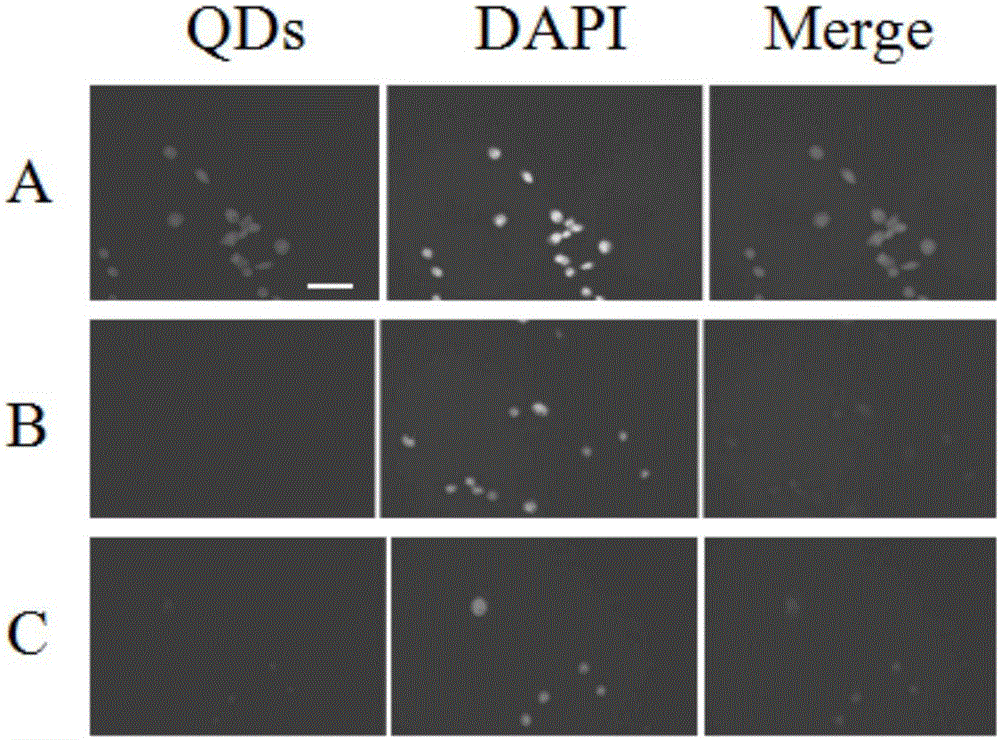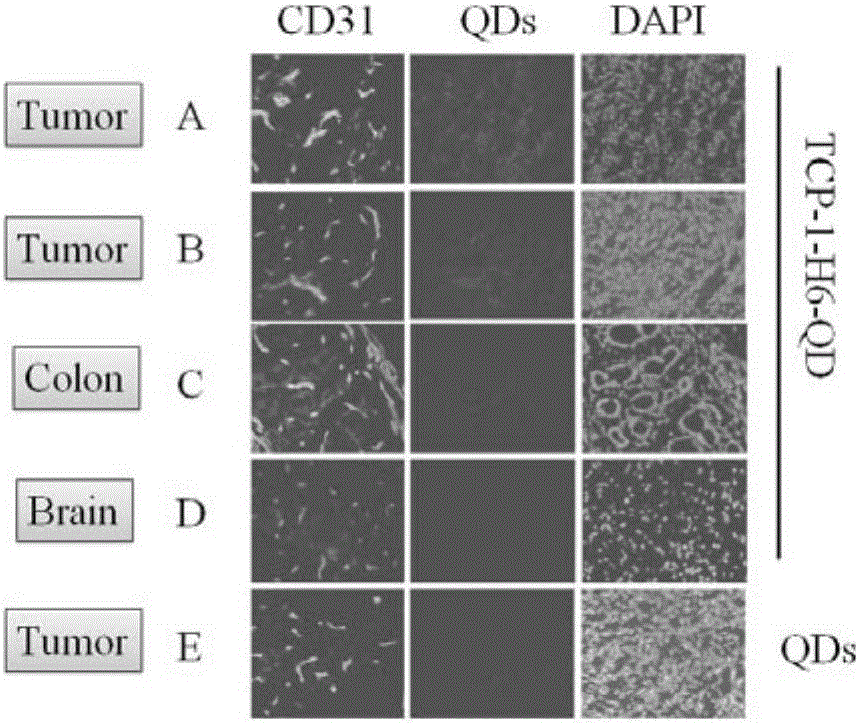Quantum dot targeting probe kit for detecting tumor of colon cancer
A technology of quantum dots and kits, applied in the field of quantum dot targeted probe kits, can solve problems such as poor photostability, easy photobleaching, and inability to display lesions.
- Summary
- Abstract
- Description
- Claims
- Application Information
AI Technical Summary
Problems solved by technology
Method used
Image
Examples
Embodiment 1
[0020] Embodiment 1 Composition and configuration of a quantum dot targeting probe kit for detecting colon cancer tumors:
[0021] The kit includes a) TCP-1-H6 polypeptide, b) TP-1-H6 polypeptide, c) water-soluble quantum dot, d) FITC, e) DAPI.
[0022] A). The polypeptide sequence of TCP-1-H6 is cyclo(1,9)-CTPSPFSHCGP 9 G 2 h 6 .
[0023] B). The sequence of TP-1-H6 polypeptide is TPSPFSHGP 9 G 2 h 6 . Both peptides were synthesized by solid phase synthesis.
[0024] C). The water-soluble quantum dots are quantum dots containing Zn, such as CdSe / ZnS, CdTe / ZnS, CdSe / ZnSe or CdTe / ZnSe. In the quantum dots, glutathione is used as a modifier to convert fat-soluble quantum dots into water-soluble quantum dots.
[0025] D). Fluorescein isothiocyanate (FITC)
[0026] E).4,6-diamidino-2-phenylindole (DAPI)
Embodiment 2
[0027] Embodiment 2 detects Colon26 cells with a quantum dot targeting probe kit for detecting colon cancer tumors, and the process is as follows:
[0028] 1. Mix the peptide and quantum dots at a ratio of 18:1, shake for 10 minutes, and remove excess peptide molecules by ultrafiltration to obtain a quantum dot-polypeptide fluorescent probe.
[0029] 2. Colon 26 cells whose nuclei were stained with DAPI were cultured in RPMI-1640 (Invitrogen) medium and incubated overnight in a carbon dioxide incubator (5% CO2, 37°C).
[0030] 3. After TCP-1-H6-QD was mixed, it was incubated at 37°C for 4 hours, and the unlabeled peptide quantum dots and TP-1-H6-QD were used as a control.
[0031] 4. The incubated cells were washed three times with PBS buffer (pH 7.4).
[0032] 5. Observe the fluorescence imaging under a Nikon C1si laser confocal fluorescence microscope (Nikon, Japan) (excitation wavelength is 488nm).
[0033] The experimental results confirmed that the fluorescence of quant...
Embodiment 3
[0034] Example 3 Using a quantum dot targeting probe kit for detecting colon cancer tumors to detect mouse colon cancer tumor tissue sections, the process is as follows:
[0035] 1. Mix the polypeptide and quantum dots at a ratio of 18:1, shake for 10 minutes, and remove excess polypeptide molecules by ultrafiltration to obtain the quantum dot-polypeptide fluorescent probe.
[0036] 2. Select colon cancer tumor tissue slices from mice containing colon cancer tumors, and select normal colon tissue and brain tissue as controls.
[0037] 3. The blood vessels in the selected tissue were stained with FITC-labeled secondary antibody, and the nuclei were stained with DAPI.
[0038] 4. After mixing tumor tissue or other tissues with TCP-1-H6-QD (100nM), incubate at 37°C for 1h.
[0039] 5. The incubated tissue was washed three times with PBS buffer (pH 7.4).
[0040] 6. Observe the fluorescence imaging under a Nikon C1si laser confocal fluorescence microscope (Nikon, Japan) (excitat...
PUM
 Login to View More
Login to View More Abstract
Description
Claims
Application Information
 Login to View More
Login to View More - R&D
- Intellectual Property
- Life Sciences
- Materials
- Tech Scout
- Unparalleled Data Quality
- Higher Quality Content
- 60% Fewer Hallucinations
Browse by: Latest US Patents, China's latest patents, Technical Efficacy Thesaurus, Application Domain, Technology Topic, Popular Technical Reports.
© 2025 PatSnap. All rights reserved.Legal|Privacy policy|Modern Slavery Act Transparency Statement|Sitemap|About US| Contact US: help@patsnap.com


